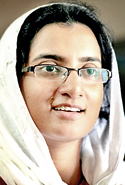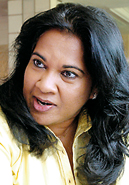Faulty genes her forte
Farah Zahir knows that for a parent, not knowing can sometimes be the heaviest of burdens. Still, she is often the last place they go looking for answers when their child isn’t developing normally. A post-doctoral fellow working at the Friedman lab and the British Columbia’s Genome Sciences Centre in Vancouver, Canada, Farah studies the genetic causes of intellectual disability in children. However, she and her colleagues only step into the arena after the other contenders have bowed out.
By this point, the doctors will have ruled out the non-genetic culprits that could have caused the child’s intellectual development to stumble, dismissing the likes of malnutrition, birth trauma and teratogenicity (“which is just a fancy word that means any harmful substances that the mother has taken in while pregnant,” says Farah.) Now, simply being able to identify a genetic cause can lift the weight of a parent’s shoulders. “For the parents it’s a big deal, because they torture themselves otherwise. It’s such a relief for them to know that this isn’t something they are responsible for.”
Of course, a diagnosis is also that crucial bit of information a doctor needs to start building treatment options. In Canada, where Farah is based, it is an important component in recruiting much needed aid from state agencies. Pioneering hospital programmes offer what amount to life-changing miracles – here an early diagnosis that pinpoints one of 80 odd Treatable Intellectual Disabilities (TID) could allow doctors to intervene before the brain is permanently damaged, thereby ensuring the child can grow up normal. For unaffected siblings within the family it is also the chance to see if they are carriers of the faulty gene.
When they find a spouse, genetic counselling could tell them whether their child would be at risk or not. Yet for many young patients and their families across the world, a diagnosis is the one thing they have been denied.
Farah estimates that 2-3% of the world’s children are afflicted with an intellectual disability. Yet the technology to diagnose them is still not widely available, where it exists at all.

Farah: Involved in pathbreaking research
“While it’s one of the most common disorders, half the time we don’t know what’s causing it,” she confesses. Ever since a scholarship won her a place in Bangalore University and a chance to enrol in her college’s very first batch for a B.Sc. in Genetics, Biochemistry and Microbiology, Farah has been fascinated with the role genetics plays in the normal development of the mind. She remembers being particularly moved by the plight of the children she saw at the Chitra Lane School in Colombo when she volunteered there as an undergraduate. “I felt really sad because they’re so neglected by society and there’s a lot of stigma attached to their condition…I guess I’ve always had this motivation to try to understand.”
Farah’s interest translated into her PhD thesis at the University of British Columbia in Vancouver, where she studied a type of gene called epigenetic modifiers. These genes are responsible for controlling the function of a number of other genes and Farah hypothesised that they had a very big part to play in neuro-development and the way the brain formed in utero. An experiment designed to test this studied 177 families made up of normal parents with affected children. “We found that these types of genes were very often malfunctioning in these children and why that’s important is you can actually correct these defects therapeutically.”
The research revealed that the drugs that could do the work of the malfunctioning genes already existed, though they were usually prescribed for different conditions. Take a medication like Valproic Acid: “It is actually used for psychiatric illness and so people hadn’t tied this together – they thought psychiatric illness in adults is different from mental illness in children.” However, scientists had begun to see the problem differently, for them these were both cases where the brain was just not functioning as it should. Such studies helped inspire the medical community to use drugs in ways they wouldn’t have otherwise – who knows what other solutions are waiting to be discovered? “So that’s the hope and the promise and it might take us twenty more years of research to get there, but Insha’Allah, we will,” says Farah.
Luckily for her, she’s found just the right place to pursue her life’s goal. The British Columbia’s Genome Sciences Centre is an exciting place to work for someone with Farah’s interests. In 2003, this was the centre which sequenced the SARS virus in matter of days, an accomplishment the World Health Organization praised as “breathtaking.” Part of their success can be credited to a multi-disciplinary approach. Farah works alongside people from very different backgrounds – computer scientists, engineers, biologists, biochemists and physicists might all contribute to cracking open a problem. Importantly, there’s also a lot of cool technology to play with. Farah only just barely contains her enthusiasm when she’s talking about the gadgets she has at her disposal. She’s been using something called Microarray to help her identify faulty genes in her young subjects but she’s looking forward to upgrading to genome sequencing technology.
A genome, encoded in DNA, contains the entirety of an organism’s hereditary information. The Human Genome Project which produced what amounted to a complete sequence of a human genome in 2003 was driven by 13 years of hard work, an estimated $3 billion in funding and the contributions of hundreds of people. Less than a decade later, the same thing can be accomplished in two weeks for roughly $4,500 and Farah is estimating that it will soon be even faster and cheaper – perhaps as low as $1000 by next year. “So, this whole science fiction story of having your entire genome sequenced, putting it on a USB, hanging it around your neck and walking into the doctor’s office might come true,” she says, laughing, “We could see things that we could only imagine before.” While the technology will give us unparalleled insight into our bodies, Farah anticipates the many social, legal and ethical conundrums we’ll have to face as a result.
She’d already received a small grant to have the genomes of 10 families sequenced. The second phase will include comparisons with families from outside Canada – she says she would love to have local families included in the international group. Here to deliver a talk for the 125th anniversary sessions of The Sri Lanka Medical Association (SLMA) last month, Farah was also interested in finding ways to bring down technology like the microarrays and to see how she can support local students in their research. She still sees herself as something of a “junior in science” but says she would like to give back what she can to Sri Lanka. Identifying the great disparity she sees in the communities around her, she says “what I’d like to do see us do is build capacity and take the whole of society forward together.”
comments powered by Disqus

























